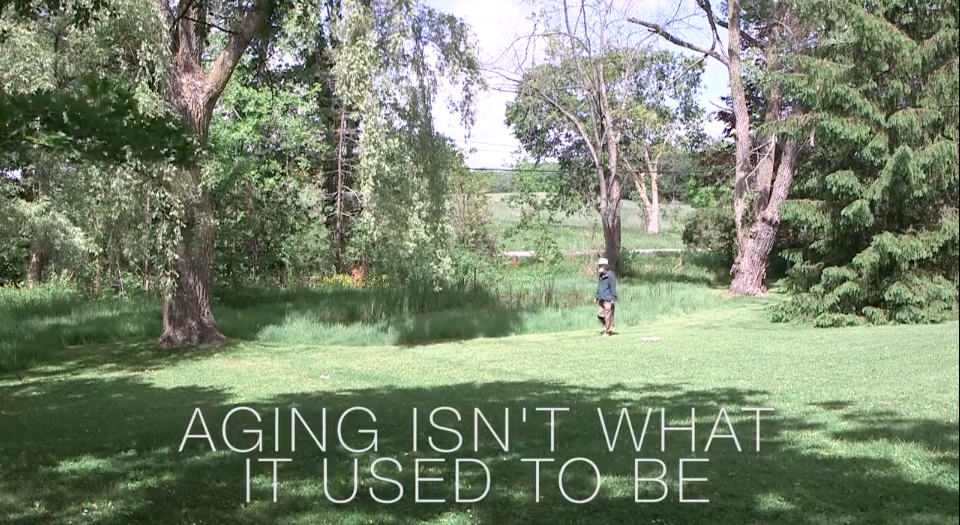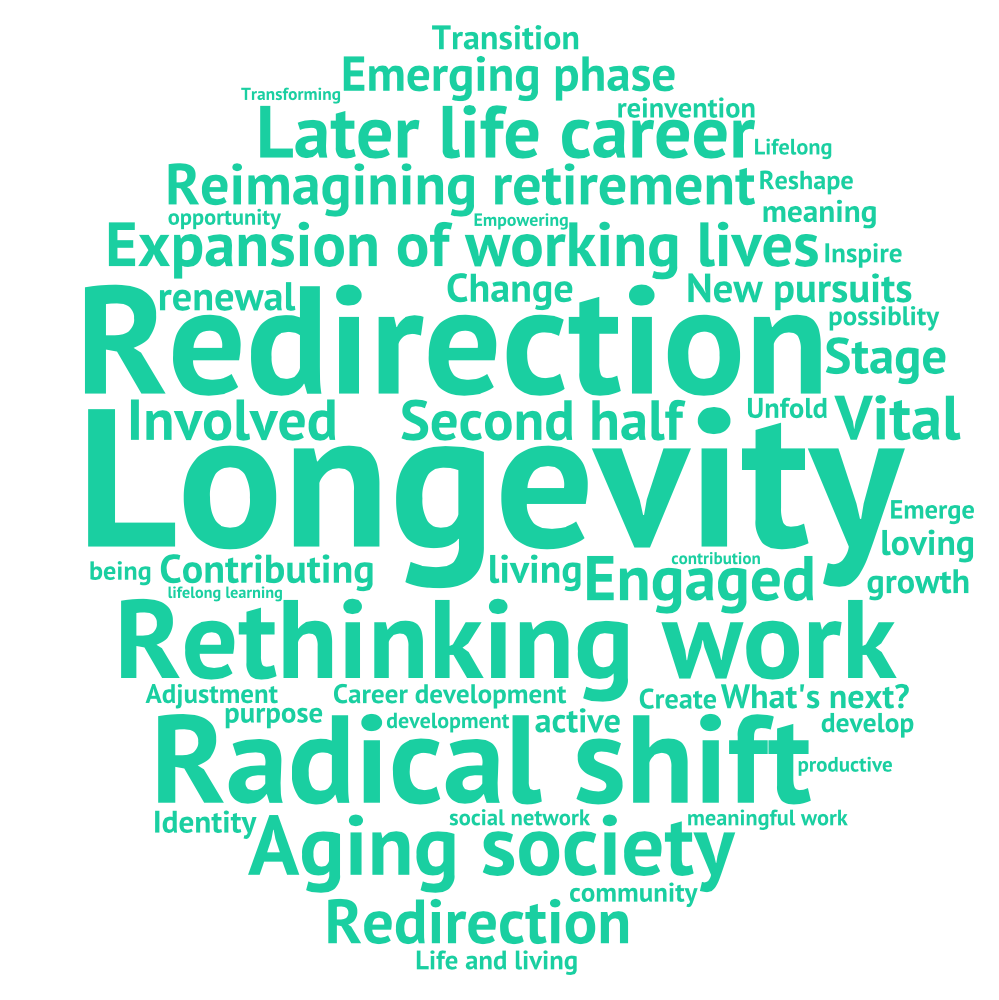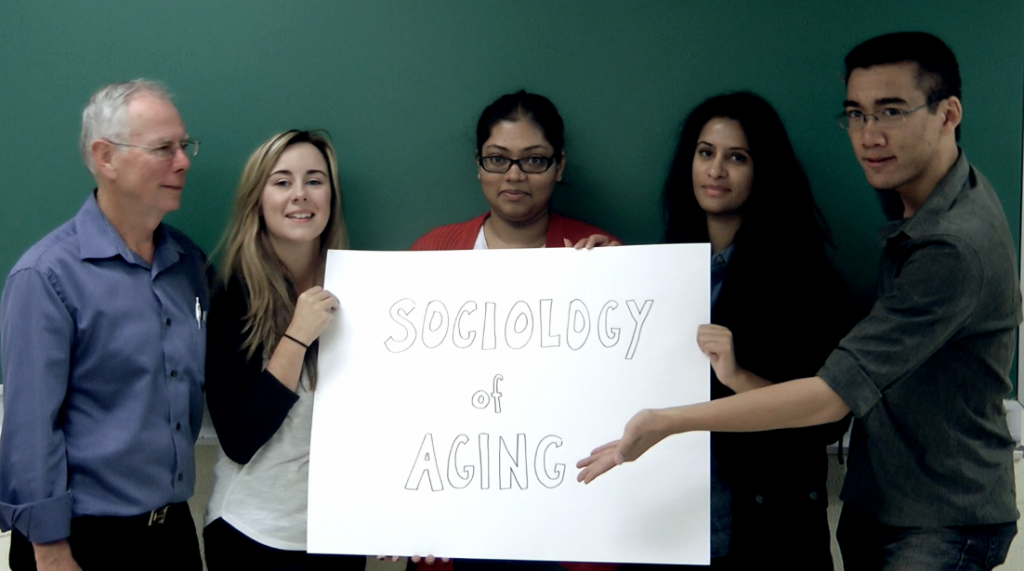Freedom of R & R, or to Continue Working
Posted by suzanne on Apr 12, 2017
There is a realignment of work and retirement in society as the population ages. It is a growing trend. Older adults are continuing to work past traditional retirement age.
CBC’s The National followed a couple of Canadians as they reflected on their decision to keep working into their later years. They found work opportunities for their ‘next act’ that help generate an income and maintain their lifestyle. Furthermore, their work is personally fulfilling and meaningful to their community.
Benefits go beyond the paycheque; working keeps people active and engaged. It was also nice to hear another perspective on the benefits of hiring mature workers.
I coined the term redirection to refer to the new stage of career as people transition into new pursuits and occupation to stay engaged and continue to work. Redirection is an alternative to retirement. It is an exciting time of life. New possibilities are investigated and explored. Older adults discover that their skills and competencies are transferable. My new documentary film explores five people’s experiences with redirection.
CBC News discusses the trend towards delayed retirement. Provinces like Nova Scotia and New Brunswick are already rethinking and implementing policy to address this new trend.
It is time to rethink government policy to consider the ways people are and can work longer and what this means for social structures and institutions in Canada.

Category: Active Engagement, Aging Population, Aging Workforce, Career, Economic Issues, Family, Health and Wellness, Intergenerational, Life and Living, Longevity, New Retirement, Relationships, Social Policy, The Redirection Project, Work
 Post Tagged with Aging Population, Business and Seniors, Documentary Film, Employment, Experienced Workers, Finance and Economics, Health, Income and Lifestyle, Later Life Work, Mature Workers, Mature Workforce, Meaningful-Later-Life-Work, New Retirement, Redirection Project, Retirement Trends, Skills, The Redirection Project
Post Tagged with Aging Population, Business and Seniors, Documentary Film, Employment, Experienced Workers, Finance and Economics, Health, Income and Lifestyle, Later Life Work, Mature Workers, Mature Workforce, Meaningful-Later-Life-Work, New Retirement, Redirection Project, Retirement Trends, Skills, The Redirection Project Older Workforce, Aging Consumers
Posted by suzanne on Feb 10, 2017
The population is aging in Canada as the baby boomer generation approaches and enters their later years. In a similar vein, the Canadian labour force is aging.
The aging population and labour force affect the Canadian economy. Policy makers, economists and government are concerned about how this will impact the economy.
Canada’s population growth is dependent upon the fertility rate, death rate and rate of immigration. Fertility rates have decreased over the decades as women have fewer children. Canadians are living longer. Immigration policy in Canada aims to bring more people into the country who can contribute to productivity and growth and compensation for the low fertility rate to keep the economy strong.
However, government, policy makers and economists do not fully recognize that older workers are eager to work and continue to work, in order to contribute to their communities. Older workers are skilled and experienced workers. They have communication, interpersonal and problem solving skills and have developed their ability to work with others. All of these skills are essential in the workplace today.
Organizational Level
As the populations ages and the workforce becomes older, all levels of society are impacted by demographic change. Importantly, this impacts organizations who are worried about a chronic labour shortage resulting from a rapidly aging population. Organizations have identified skill shortages in different roles across various industries. This is a top priority for business leaders.
Around the globe, other countries are innovating to address these concerns. These countries believe that the best way to adopt a successful aging strategy is to realize that aging is an opportunity.
One example is Japan, where policy makers have been steering the growing number of healthy 60- and 70 year olds away from retirement into work. These mature workers are taking on work roles and this makes them productive members of society. They hold jobs ”that otherwise would be impossible to fill as the population shrinks.” 1
Furthermore, an entrepreneurial focus on the aging demographic, with products and services to support aging, ensures that aging is a benefit that broader society can reap.
Although consumer spending growth overall is weak in Japan, economists at UBS Securities there say they believe the expansion of the senior market could more than offset any declines that come from a shrinking population, at least for a time.2
For Japan, the way forward is clear. For more, visit Aging Gracefully in the Wall Street Journal.
Footnotes:
1,2Schlesinger, J. M. & Martin, A. (2015). Entrepreneurs are exploring robotics and other innovations to unleash the potential of the elderly. Aging Gracefully: Graying Japan Tries To Embrace the Golden Years.

Category: Aging, Aging Population, Aging Workforce, Business, Economic Issues, Longevity, Services for Seniors, Social Policy, Work
 Post Tagged with Aging Labour Force, Aging Population, Employment, Finance and Economics, Mature Workers, Mature Workforce
Post Tagged with Aging Labour Force, Aging Population, Employment, Finance and Economics, Mature Workers, Mature Workforce Mature and Experienced Workers
Posted by suzanne on Feb 1, 2017
Older adults are continuing to work into their later years. They work for meaning, purpose, engagement, stimulation…and a paycheque.
Some individuals retire, then decide it is time to go back to work.
This is a beautiful video telling the story of one woman who retired, then decided to keep working into her later years.
Mature and experienced workers have a lot to offer. It is challenging and rewarding to redirect into new occupational pursuits.

Category: Aging Workforce, Career, Economic Issues, Longevity, New Retirement, Relationships, Work
Knowledge Sharing: Later Life Career
Posted by suzanne on Dec 8, 2016
 Redirection is an alternative to retirement. A large and growing proportion of older adults are choosing to work past what has traditionally been thought of as ‘retirement age’. This represents a significant shift in our society.
Redirection is an alternative to retirement. A large and growing proportion of older adults are choosing to work past what has traditionally been thought of as ‘retirement age’. This represents a significant shift in our society.
The Redirection Project examines this new and emerging social trend. Results of the research will be shared in January. First, a webinar will be held on January 12th, 2017. Sign up here. Second, there is a presentation at Cannexus17 in Ottawa on January 23rd. Sign up here.
The documentary film Redirection: Movers, Shakers and Shifters discusses these issues and portrays the stories of five adults who found second or third careers after age 50. The English and French trailers of the film are available. The documentary film is been screened through feature presentations around the country to great acclaim.

Category: Active Engagement, Aging, Aging Workforce, Career, Economic Issues, Longevity, New Retirement, Research, The Redirection Project, Work
 Post Tagged with Aging, Aging Labour Force, Aging Population, Cannexus conference, Documentary Film, Employment, Engagement, Experienced Workers, Finance and Economics, Income and Lifestyle, Later Life Work, Mature Workers, Mature Workforce, Meaningful-Later-Life-Work, New Retirement, Redirection Project, Research, Retirement Trends, The Redirection Project
Post Tagged with Aging, Aging Labour Force, Aging Population, Cannexus conference, Documentary Film, Employment, Engagement, Experienced Workers, Finance and Economics, Income and Lifestyle, Later Life Work, Mature Workers, Mature Workforce, Meaningful-Later-Life-Work, New Retirement, Redirection Project, Research, Retirement Trends, The Redirection Project Work and Aging: Symposia
Posted by suzanne on Aug 29, 2016
Work and occupation are important across the life course. It is a great thrill to share the most recent research on work and aging at the upcoming CAG annual scientific and educational meeting to be held in Montreal, Quebec. At this year’s conference, I am chairing two Symposia on work and aging. I have invited some esteemed scholars to present their work. The Symposia are to be held on Saturday, October 22nd, 2016.
During the first Symposium, I will be discussing the Redirection Project. During the second Symposium, I am sharing the documentary film Redirection: Movers, Shakers and Shifters which helps bring key issues from my Redirection Project to a broader audience.
Symposium I: Policy Imperatives for Later Life Work
Symposium II: Movers, Shakers and Shifters: Later Life Career Redirection
It is very exciting to have scholars presenting on issues surrounding work and aging and gratifying to see this much attention devoted to work and occupation as people age at CAG. As a broad gerontological topic, work and aging is particularly relevant and timely as the large cohort of baby boomers approach later life and gain their own perspective on being mature and experienced workers.

Category: Aging, Aging Population, Aging Workforce, Career, Economic Issues, Longevity, Research, The Redirection Project, Work
Extension of Working Life
Posted by suzanne on May 25, 2016
 People are working during later life. This is a new social trend and it is occurring as the Baby Boomers enter their later years. Recent surveys and polls all point to this shift in Canada.
People are working during later life. This is a new social trend and it is occurring as the Baby Boomers enter their later years. Recent surveys and polls all point to this shift in Canada.
This trend is occurring for many reasons. Some people cannot afford to retire. They need to pay bills. They need to be gainfully employed past traditional retirement age. They have not saved enough to retire. They are in debt. In other words, they cannot retire and live on a fixed income.
CBC Radio’s The Current highlighted the challenges of some of these individuals. Listen to the podcast.
Other people want to continue working. They gain a great deal from their paid work. For example, work provides self worth and self-esteem, mental stimulation, physical activity and social relationships. Some of these individuals might have retirement savings, so income generation is viewed as a benefit but it is not the primary motivation. They might be professionals who are highly educated. They believe they have more to contribute; they are not ready to retire.
When I started conducting the Redirection Project and investigating later life career development, career shift and career extension, I recognized that there is a dichotomy among older workers. Some must work; some want to work. It is great to hear from older adults about their diverse experiences (and the surveys are still available for participation). Both of these experiences are important to understand; hence, I developed the on-line surveys to reflect both sets of circumstances. The fact is that socio-economic circumstances have changed a great deal since the retirement system was developed.
Indeed, paid work during later life is important. Paid work represents many things to individuals. Motivations for later life paid work are complex. This new trend is a big shift from the previous model of retirement. It is a big shift within workplaces as well. Policy to address this social change must be carefully handed.
This is why the qualitative and quantitative datasets collected through the Redirection Project are critical for gaining a better understanding of later life career development and employment experiences and informing social policy, organizational programs and career development practice. For more information about the Redirection Project, please visit www.MyRedirection.com.
Redirection Project
Posted by suzanne on Jan 26, 2016
 More and more people are pursuing a longer working life. Redirection speaks to this rethinking of work and income options for later life.
More and more people are pursuing a longer working life. Redirection speaks to this rethinking of work and income options for later life.
I coined the term redirection to refer to the new stage of career as individuals transfer their skills, experience and knowledge in a new direction. By pursuing a new occupation, individuals are able to use some of their strengths while learning something new. This provides revitalization.

Northumberland County residents are invited to participate in the Magnet Redirection Project as part of the age-friendly initiative.
Attention Northumberland County Residents, please click here: Magnet Redirection Project.
The Redirection Project examines how Canadians in their 50s, 60s and beyond are turning away from traditional notions of ‘retirement’ to seek new employment. There is a radical change taking place with an expansion of our working lives and re-imagining of retirement as the baby boomers enter what has traditionally been viewed as their retirement years.
The Redirection Project is a CERIC-funded national research initiative. The project consists of a national survey (see below), success stories to help inspire others and a documentary film (see the story contest).
The research examines partipants’ experiences with later life work and career development as they shift gears and pursue new types of work.
If you are age 50 or over and seeking new employment (or have already found your new career), you are invited to participate in important research about this topic in order to help others in similar circumstances.
To participate, please click on one of the following links.
Redirected and working in a career
Seeking redirection and looking for a new occupation
The project has received great coverage in the Globe and Mail.
Recent York University YFile press: September 2015 and January 2016 articles.
Aging, the Social and Demographic Trend
Posted by suzanne on Oct 1, 2015
This week, Statistics Canada reported that older adults age 65 and over now outnumber children and youth under 15 years of age. This is a new social trend that is expected to continue and in fact grow in the future. This demographic change will certainly impact society.
There are more older adults in Canada than ever before. They are a diverse group with a variety of needs. Furthermore, as they move through the life course, this demographic group continues to have social impact on social institutions and vice versa.
There is work to be done to address issues related to our aging population and bigger conversations that we need to be having about our aging society. Innovative policy, programs and services as well as more research and education about issues and topics related to aging and older age are required to help Canada and Canadians adjust to the social change we are experiencing.
Aging is an interdisciplinary field. It requires specialized as well as holistic, broad-based knowledge. The new collaborative partnership on aging research and education between York University and Trent University that connects their new aging-focused research centres is an innovative example of what is needed going forward.
The new research centres at York and Trent both have an interdisciplinary focus and a mandate to increase the capacity for research and education on aging and aging issues. With this partnership, York and Trent can effectively capitalize on the strengths, perspectives and expertise of scholars and researchers in the field of aging and accomplish even more innovative work. Furthermore, it will enable these two institutions to bring more resources and various viewpoints and experiences to bear on issues related to aging. The partnership will provide a holistic understanding of aging that can inform policy, programs and services for stronger, healthier communities. This is what will assist Canada to adjust to the shifting demographics and changing social needs.
What a coincidence that we are talking about this population shift and what is needed in time for October 1, the day the federal government has designated as National Seniors’ Day.
Going forward, however, there is great need to be forward thinking, innovative and purposeful to address the social and demographic changes we are experiencing.
A version of this blog was posted on LinkedIn on October 1st, 2015.

Category: Aging, Aging Population, Longevity, Services for Seniors
Intergenerational Education
Posted by suzanne on Dec 9, 2014
What happens when lifelong learners are invited into spaces and places normally reserved for young learners? You get Intergenerational Education. This new and emerging type of education occurs when you mix passion, dynamic innovation and out of the box thinking and bring it all into the classroom. The results and the benefits are phenomenal.
Dr. Chris Alfano, my colleague in Kingston, teaches high school students and older adults in an intergenerational music program. The vibrancy of this classroom is incredible and it has been my pleasure to observe this class on more than one occasion. Chris and his music class received some much deserved attention for the incredible work they all do to bring music into people’s lives through intergenerational education. Great joy is created when they share what they have learned and bring music out into the community.
I teach Sociology of Aging at York University using an intergenerational education model. I have been thrilled to see this new trend catching on. Recently, I visited two intergenerational education class opportunities. This confirmed the rich learning potential for young and old alike.
Last week, I visited the University of Victoria to observe an interdisciplinary, intergenerational class as well as speak with the professors leading this course (The YUFA Teaching and Learning Development Grant that I received from York University facilitated my visit). The UVic students are enrolled in ‘Exploring Aging through Film’. What an inspired idea for an interdisciplinary university course that brings young and old together while strengthening links between research and teaching. This course is the brain child of Dr. Holly Tuokko and her colleagues. The support for this creative course, the vibrant learning environment and the high student interest were striking. It was wonderful to see the development of intergenerational education and how far it has progressed on the West Coast.
My colleague at York, Dr. Gary Turner, also incorporated intergenerational learning into his class for the first time two weeks ago. Again, everyone was pleased with the results and I have every expectation that he will do it again next year.
These classes use Experiential Education to engage students, both young and old. This model has rich potential.
There is a new brand of education emerging in the field and it demands that we pay close attention to it.

Category: Active Engagement, Aging, Aging Population, Health and Wellness, Intergenerational, Life and Living, Lifelong Learning, Longevity, Relationships
 Post Tagged with Aging, Aging Population, Community, Engagement, Exercise, Experiential Education, Intergenerational, Intergenerational Education, Relationships, Society, Well-being
Post Tagged with Aging, Aging Population, Community, Engagement, Exercise, Experiential Education, Intergenerational, Intergenerational Education, Relationships, Society, Well-being Maggie Kuhn, the Cultural Revolution and a Society for All Ages
Posted by suzanne on Aug 3, 2014
This August, it is timely to recognize leading-edge American social activist Maggie Kuhn for her work in the field of aging. August 3rd marks the 109th year since her birth. Maggie was a champion of aging and the later years. She founded the Gray Panthers in August 1970.
Maggie’s work is notable not only because she was ahead of her time with her vision. She also broke stereotypes and, at age 65, embarked on the most important work of her life. In fact, rather than accept being pushed into a quiet retirement by her employer and societal pressure, she chose to take action and work for the rights of older people. After being forced into retirement from the Presbyterian Church, Maggie, along with her friends who found themselves in similar circumstances, organized and founded the group that became the Gray Panthers. The organization focused on the issues of older people including pensions and pension rights, health care and age discrimination. Gray Panthers also addressed the larger social issues of the time such as the Vietnam War.
“By the year 2020, the year of perfect vision, the old will outnumber the young.”
~Maggie Kuhn
Maggie was a charismatic and energetic leader. She advocated for older adults to have a voice and the opportunity to provide input into programs, practice and social policy. She encouraged older adults to stay involved and take action on social issues. In doing so, she started a cultural revolution.
Maggie also believed in the power of intergenerational connection. One of her mantras was ‘Young and old together’. Under her guidance, Gray Pantners came to represent the possibility and power of later life and to stand for social and economic justice and peace for all ages. The organization’s motto is ‘Age and Youth in Action’ very much echoing Maggie’s sentiments. Maggie herself demonstrated how older adults can be active in the world, working for social issues that are important to them.
“Learning and sex until rigor mortis.”
~Maggie Kuhn
Until her death at age 89, Maggie continued her work as an activist and advocate. She redefined aging and is a role model to all of us – women and men, young and old alike.
“There must be a goal at every stage of life! There must be a goal!”
~Maggie Kuhn
Maggie Kuhn was a visionary leader. She inspired many people to view aging differently. She left an incredible legacy. Unfortunately, ageism, discrimination and lack of intergenerational connection continue to be issues that require attention in our society. These are barriers to a cultural revolution that would shift our society from a youth-oriented culture to a society for all ages. In our aging society, we need more people like Maggie to help move the cultural revolution forward.

Category: Aging, Aging Population, Intergenerational, Longevity, New Retirement
 Post Tagged with Aging, Aging Population, Community, Elderhood, Engagement, Intergenerational, Meaningful-Later-Life-Work, New Retirement, Society
Post Tagged with Aging, Aging Population, Community, Elderhood, Engagement, Intergenerational, Meaningful-Later-Life-Work, New Retirement, Society 






